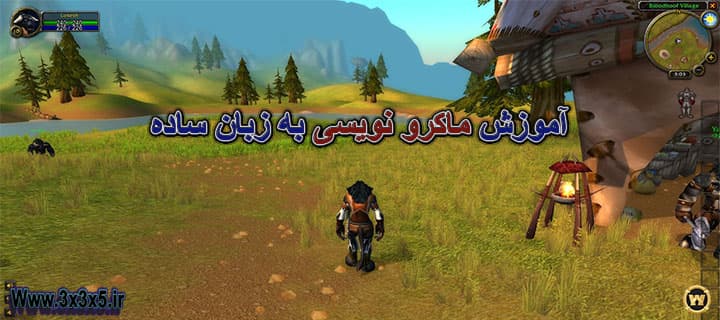Training and making MACRO
If you want to get acquainted with the concept and application of Macro, read this article. In this post, we will explain how Macros work and make some Macros for ourselves. After reading this post, you can create any type of Macro depending on your needs, and Speed up your gameplay.
- In this post, you will get acquainted with the following tutorials:
- What is a macro and how do I create a macro?
- Macro relationship with Abilities and Items
- How does a macro work?
- Targets
- Cast Manager
- Correction and relocation of Stance
- Move to Salah
- What can not be done with macros!
It can be said that there is almost no professional player in Blizzard who does not use Macro. In fact, Macro has given another meaning to WOW. Macro gives you more possibilities and creates a significant increase in the speed of your game, especially For PVP works
- What is a macro and how do I create a macro?
Macro can be considered as a small programming language that is limited in the game space and can be used only by writing code and has no graphical relationship, macro allows you to do several things at once with just one click, for example 2 spells Use in one click
To use the macro you can press the ESC key and select Macro or type in the game macro / and new , now you are ready to create a macro
- How does a macro work?
It is enough to be familiar with some basic terms of this system to create a macro, for example, we type lol / and we create a macro.
In macros, usually with the option
show #
or
showtooltip #
Which is located at the first line of each macro, the meaning of which is explained below.
- show #: With this code you can replace the icon of each spell with your macro icon. For example, I want to set my macro icon to Fireball, so I type in the first line of the macro.
- show fireball #, now my macro is visible with the Fireball icon
- showtooltip #: But what happens if this is in the first line, if you have seen when we hover the mouse over a spell we see its description like Cooldown value etc. This code causes our macro icon depending on the type Display the information we have given it, for example
- We have in the macro
code:
# showtooltip / cast fireball
Now if you hover the mouse over the macro icon you will see a description of the Fireball spell.
- Macro relationship with Abilities and Items:
Well, for example, we have a paladin hero and we want to create a macro that runs one or more spells at the same time,
just type the
code:
# showtooltip / cast Avenging Wrath / cast Divine Shield
The result of running 2 spells is just one click, I suggest you enter the game now for more understanding and you also create a simple macro, just delete the red words in the macro above and enter the name of the spell that belongs to your class. .
- Items Items:
Well, now we want to create another macro that deals with our items. Consider the following example
: Code:
# showtooltip / use 13 / cast SPELLNAME
The macro comes up and runs item number 13. Now what is your item 13? Your item 13 is part of Trinket, with the formula below the number 13 will be more understandable to you.
- Head
- Neck
- Shoulder
- Shirt
- Chest
- Belt
- Legs
- Feet
- Wrist
- Gloves
- Finger 1 (top)
- Finger 2 (bottom)
- Trinket 1 (top)
- Trinket 2 (bottom)
- Back
- Main Hand
- Off Hand
- Ranged / Relic
- Tabard
As you can see, the number 13 is Trinket 1, and if the number inside the macro, for example, is 14, your Trinket 2 will run.
- Targets?
I got to my favorite section, it is really useful to read, first pay attention to the following example
code:
# showtooltip / cast [@focus] SPELLNAME
The macro above uses the splay on our focused target. Now what is the focus?
For example, click on a hero, then right-click on the icon that appears and select the focus option. As you can see, the icon and its name will appear separately on the screen. Now if we use the macro above The spell in SPELLNAME is used directly on our focus. Now, whether you click on the side or not, the macro detects that it must use the spell on your focus!
This macro is mostly used for PVE, for example, you are a healer and you no longer need to find the tank, then click the method, then give Healesh, just focus on the tank at the beginning, and then heal easily with the macro.
One of the advantages of this macro is Arena 2v2. Focus on your friend and set macros such as Buff or Hill to be used without the need to click directly on your friend.
- There are other ways to use spells on your targets:
- [target]: When this is an alternative to @focus, you have to click on the Target side to run the macro, it is almost unusable
- [player]: If you want to give yourself a Buff, you have to click on yourself, but with this code, even if your Target is on your friend, this Buff will still run on you and there is no need to change the Target! It is very useful…
- [target target]: This causes our macro to run on another person’s Target. For example, I click on my friend and my friend clicks on the enemy. As a result, the macro runs on an enemy targeted by your friend.
- [arena1]: Well, it’s almost certain that if we use this, the macro will run on our No. 1 teammate, you can increase its number to 5
- [party1]: Like above, the macro runs on our No. 1 team. You can increase it to 5, because parties can accommodate up to 5 players.
- [raid1]: Like above, the macro runs on our number 1 reed. You can increase the number to 40, because raids consist of 40 players.
Sometimes you need to delete the Targets. For example, I clicked on someone but I want to remove my click from this player. You can use the following
code:
/ cleartarget
Sometimes you want to target the person you last clicked on. We use the following
code:
/ targetlasttarget
- Cast Manager Cast Management:
Well now we come to the management of casts, we all know that spells have Global Cooldown may interfere with our macro and not work properly, the solution to this is to manage spell casts that I explain below, for example below Notice, assuming you have a Rogue.
code:
# show / castsequence [stance: 1/2] reset = 2 Shadowstep, Sap / castsequence [stance: 0/2] reset = 2 Shadowstep, Kick
As you can see in the macro above, we separated the names of the spells by a “,” . This causes us to go to the next spell after each macro click.
- spell1, spell2, spell3
Well, if I click on the macro once, spell1 will run, hit again, spell2 will run, and if I tap again, spell3 will run, so in this macro, we need to click on the macro 3 times to perform exactly all the operations we wrote in the macro. The difference between this macro and the higher macro is that it is not Auto and is step by step.
- castquence: Allows you to do a few things step by step with a macro. You will see in the following examples.
- stance: Stance means the same as Form Hero. For example, if you go to Invis mode with Rogue, it is called Stance change, and you know that Rogue has 2 modes: Stealth and Shadow Dance, so we have 2 Stans when you select [stance: 1/3]. This means that we want this macro to be done in Stealth mode. Note the following explanation
0/3: Hero Natural Mode
1/3: Stealth
2/3: Vanish
3/3: Shadow Dance
At the bottom I list all the Stances
- Overall result:
In the first macro line above we conclude that the first line only runs when I am in Stealth mode, in the second macro line we conclude that the second line only runs when I am in normal mode
- reset: As its name suggests, it resets macro activities. The same option has several options, but in the macro above, which we wrote, reset = 2 means that the macro is reset to the first state after 2 seconds.
- Reset options:
- reset = 1: resets in seconds
reset = target: A simple example: for example, your old target is killed and when you click on the new target, it is macro reset! - reset = combat: When you are in combat mode, the macro will start again
- reset = nocombat: Macro restarts when you are in nocombat mode
- reset = shift: Each time you press SHIFT, your macro will return to its original state. You can also change it to Alt or ctrl.
For more understanding, consider the following example (assuming you have a mage)
Code:
/ castsequence reset = 24 Frost Nova, Blink
Well, this 24 means 24 seconds. If you do not reach Blink within 24 seconds, the macro will reset again and start working with Cast Frost Nova! , I hope you understand.
Another option that reset gives us is to determine whether the hero is combat or non-combat.
Consider the following example:
Return to the rogue class of
code:
# showtooltip / castsequence reset = nocombat Shadowstep, Kick
Well, in the macro above, we explained to the reset that if we exit combat, the macro will be reset, and vice versa, if we change to combat, when we are in combat, the macro will be reset.
- Modify and move Stance:
Well, you are somewhat familiar with the meaning of Stance above, but in this other explanation, you will see that we also introduce combat or nocombat spells to cast the desired spell at the right time.
Consider the following example:
Code:
# showtooltip / cast [combat] vanish / cast [nocombat] stealth
- [b] [combat]: When we were in Combat
- [nocombat]: When we were not in Combat! Simple
You know that Vanish gives Rogue the ability to become stealth in combat mode, so with the macro above we first detect if it was vanish if we were in combat, then immediately when we leave combat it changes us to stealth mode.
- Change Stance:
You know that there are only 5 classes that can change the Stance, so this type of macro can be used for these 5 classes
Priest – Warlock – Warrior – Rogue – Druid
- List of Stances of each class:
0 = Natural
1 = Stealth
2 = Vanish
3 = Shadow Dance
- Warrior:
0 = Normal
1 = Battle Stance
2 = Defensive Stance
3 = Berserker Stance
- Druid:
0 = Natural
1 = Bear
2 = Aquatic
3 = Cat
4 = Travel
5 = Moonkin / Tree | Swift Flight Form *
6 = Swift Flight Form *
- Priest:
0 = Natural
1 = Shadowform
- Warlock:
0 = normal
1 = ????
2 = Metamorphosis
Now if in macro we want to switch on each of the above Stances and use a spell, we do the following:
code:
# showtooltip / cast [stance: 1/3] Sap / cast [stance: 0/2] Gouge
Find stance 1/3 above Rogue What is written? True Stealth, so if we are in stealth mode, SAP is running, well we know the meaning of Stance, now we leave the topic of Stance!
Note this macro:
code:
# showtooltip / cast [mod: shift] Shiv; Backstab
We added a new mod as well as “;” As you can see in the macro above, I will explain below what their use is
mod: You must use this code to select a key from the keyboard, it means “mode”
- mod options:
- mod: shift: If you hold Shift, the introduced spell will run
- mod: alt: If you hold Alt….
- mod: ctrl: [b] If you hold ctrl….
Important Note: mod is always placed in a box like this [mod: alt] and if we want to introduce a spell when we get Alt, we have to write it like this
: Code:
[mod: alt] shive;
the mark ” ; ”: This should be placed at the end of the spell name to introduce it to the mod so that when you use Alt mode the spell shive is executed if”; Otherwise it will not be implemented
New code called harm:
has 2 options with the following names
[harm]: If it is an enemy
[noharm]: If it is not an enemy
Note the following macros:
code:
# showtooltip / cast [@target, harm] Blind; Blind
Well, the macro comes and finds the target and says if my target was an enemy, the macro should run, otherwise it should not run, and there are a series of spells that you should run on your friend or non-enemy, so we change it to noharm
New code called help and dead, nodead:
[help] : This does the same thing as noharm, but it’s better to use it. Note the following macro
.
Was macro run
Consider the following example:
Code:
# showtooltip / cast [@target, nodead, help] tricks of the trade; tricks of the trade
The macro runs when Target is not dead and is our friend.
- Move Salah:
So far, in the middle of the conflict, you want to change your Weapon or item, and this will take a relatively long time, which is not good at all in the middle of the conflict, so we will build a macro and get ready for battle.
Our macro always starts with equip /
You can do it in 2 ways, first pay attention to the following macro
code:
/ equip ITEM NAME
Well, this macro finds the item called ITEM NAME in your bag (bag) and automatically replaces it if it is shield, replaces it with head if it is head, etc.…
You can replace several items at the same time
code:
/ ITEM NAME equip / ITEM NAME2 equip / ITEM NAME3 equip / ITEM NAME4 equip
But there is another way, consider the following example, look at this list first:
- Head
- Neck
- Shoulder
- Shirt
- Chest
- Belt
- Legs
- Feet
- Wrist
- Gloves
- Finger 1 (top)
- Finger 2 (bottom)
- Trinket 1 (top)
- Trinket 2 (bottom)
- Back
- Main Hand
- Off Hand
- Ranged / Relic
- Tabard
Well now we have a macro like the following
code:
/ equipslot 16 WEAPON NAME
This directly replaces the item in question with slot 16, which is the main hand according to the list above, but what is the difference with the above code?
Well, for example, we know that Trinket and Finger each have 2 slots. If we use the first code, it may automatically change the trunk with your first trunk. If you wanted to change it with the second trinket, then we will come from the following code. We use to hit the target directly
Code:
/ equipslot 14 Trinket NAME
- What can not be done with Macro!
Unfortunately, there are some disadvantages in macro, for example:
- Cannot recognize position
- Unable to determine Health level or classes
- Can not detect Range
- Unable to specify cooldown
And to understand what I wrote, I was searching for a movie and I found it in google, which is good for beginners.
And here is a video of Iranian children in connection with macro writing



